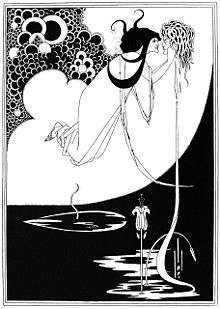Aubrey Beardsley
| Aubrey Beardsley | |
|---|---|
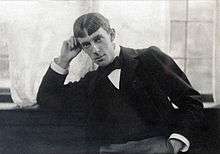 Portrait of Beardsley by Frederick Hollyer, 1893 | |
| Born |
Aubrey Vincent Beardsley 21 August 1872 Brighton, England |
| Died |
16 March 1898 (aged 25) Menton, France |
| Nationality | English |
| Education | Westminster School of Art |
| Known for | Illustration, Graphics/Graphic arts |
| Movement | Art Nouveau, Aestheticism |
Aubrey Vincent Beardsley (21 August 1872 – 16 March 1898) was an English illustrator and author. His drawings in black ink, influenced by the style of Japanese woodcuts, emphasized the grotesque, the decadent, and the erotic. He was a leading figure in the Aesthetic movement which also included Oscar Wilde and James A. McNeill Whistler. Beardsley's contribution to the development of the Art Nouveau and poster styles was significant, despite the brevity of his career before his early death from tuberculosis.
Early life, education and early career

Beardsley was born in Brighton, England, on 21 August 1872, and christened on 24 October 1872.[1] His father, Vincent Paul Beardsley (1839–1909), was the son of a tradesman; Vincent had no trade himself, and relied on a private income from an inheritance that he received from his maternal grandfather when he was 21.[2] Vincent's wife, Ellen Agnus Pitt (1846–1932), was the daughter of Surgeon-Major William Pitt of the Indian Army. The Pitts were a well-established and respected family in Brighton, and Beardsley's mother married a man of lesser social status than might have been expected. Soon after their wedding, Vincent was obliged to sell some of his property in order to settle a claim for his "breach of promise" from another woman who claimed that he had promised to marry her.[3] At the time of his birth, Beardsley's family, which included his sister Mabel who was one year older, were living in Ellen's familial home at 12 Buckingham Road. The number of the house in Buckingham Road was 12, but the numbers were changed years ago, and it is now 31.[4]

In 1883 his family settled in London, and in the following year he appeared in public as an "infant musical phenomenon", playing at several concerts with his sister.[5] In January 1885 he began to attend Brighton, Hove and Sussex Grammar School, where he would spend the next four years. His first poems, drawings and cartoons appeared in print in "Past and Present", the school's magazine. In 1888 he obtained a post in an architect's office, and afterwards one in the Guardian Life and Fire Insurance Company. In 1891, under the advice of Sir Edward Burne-Jones and Pierre Puvis de Chavannes, he took up art as a profession. In 1892 he attended the classes at the Westminster School of Art, then under Professor Fred Brown.[6][5]
Work
In 1892, Beardsley travelled to Paris, where he discovered the poster art of Henri de Toulouse-Lautrec, and the Parisian fashion for Japanese prints, both of which would be major influences on his own style. Beardsley's first commission was Le Morte d'Arthur by Thomas Malory (1893), which he illustrated for the publishing house J. M. Dent and Company.[7]
His six years of major creative output can be divided into several periods, identified by the form of his signature. In the early period his work is mostly unsigned. During 1891 and 1892 he progressed to using his initials, A.V.B. In mid-1892, the period of Le Morte d'Arthur and The Bon Mots he used a Japanese-influenced mark which became progressively more graceful, sometimes accompanied by A.B. in block capitals.[8] He co-founded The Yellow Book with American writer Henry Harland, and for the first four editions he served as Art Editor and produced the cover designs and many illustrations for the magazine. He was also closely aligned with Aestheticism, the British counterpart of Decadence and Symbolism. Most of his images are done in ink, and feature large dark areas contrasted with large blank ones, and areas of fine detail contrasted with areas with none at all.
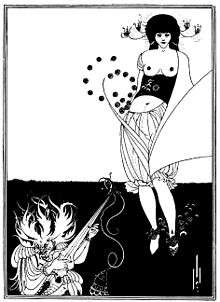
Beardsley was the most controversial artist of the Art Nouveau era, renowned for his dark and perverse images and grotesque erotica, which were the main themes of his later work. His illustrations were in black and white, against a white background. Some of his drawings, inspired by Japanese shunga artwork, featured enormous genitalia. His most famous erotic illustrations concerned themes of history and mythology; these include his illustrations for a privately printed edition of Aristophanes' Lysistrata, and his drawings for Oscar Wilde's play Salome, which eventually premiered in Paris in 1896. Other major illustration projects included an 1896 edition of The Rape of the Lock by Alexander Pope, and the collection A Book of Fifty Drawings by Aubrey Beardsley (1897).[7]
He also produced extensive illustrations for books and magazines (e.g. for a deluxe edition of Sir Thomas Malory's Le Morte d'Arthur) and worked for magazines such as The Studio and The Savoy, of which he was a co-founder. As a cofounder of The Savoy, Beardsley was able to pursue his writing as well as illustration, and a number of his writings, including Under the Hill (a story based on the Tannhäuser legend) and “The Ballad of a Barber” appeared in the magazine.[9]
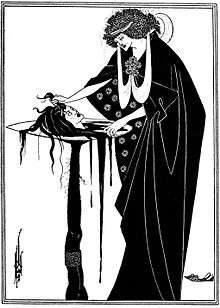
Beardsley was a caricaturist and did some political cartoons, mirroring Wilde's irreverent wit in art. Beardsley's work reflected the decadence of his era and his influence was enormous, clearly visible in the work of the French Symbolists, the Poster art Movement of the 1890s and the work of many later-period Art Nouveau artists such as Pape and Clarke. Some alleged works of Beardsley's were published in a book titled Fifty Drawings by Aubery Beardsley, Selected From the Collection of Mr. H. S. Nicols. These were later discovered to be forgeries, distinguishable by their almost pornographic erotic elements, rather than Beardsley's somewhat more subtle use of sexuality.[10]
Private life
Beardsley was a public as well as private eccentric. He said, "I have one aim—the grotesque. If I am not grotesque I am nothing." Wilde said he had "a face like a silver hatchet, and grass green hair."[11] Beardsley was meticulous about his attire: dove-grey suits, hats, ties; yellow gloves. He would appear at his publisher's in a morning coat and patent leather pumps.
Although Beardsley was associated with the homosexual clique that included Oscar Wilde and other English aesthetes, the details of his sexuality remain in question. He was generally regarded as asexual. Speculation about his sexuality include rumours of an incestuous relationship with his elder sister, Mabel, who may have become pregnant by her brother and miscarried.[12][13] During his entire career, Beardsley had recurrent attacks of tuberculosis. He suffered frequent lung haemorrhages and was often unable to work or leave his home.
Beardsley converted to Roman Catholicism in March 1897, and subsequently begged his publisher, Leonard Smithers, to “destroy all copies of Lysistrata and bad drawings... by all that is holy all obscene drawings." Smithers ignored Beardsley’s wishes, and actually continued to sell reproductions as well as forgeries of Beardsley's work.[8]

Death
In 1897 deteriorating health prompted his move to the French Riviera, where he died a year later on 16 March 1898 at the Cosmopolitan Hotel in Menton, France, attended by his mother and sister. He was 25 years of age and the cause of death was tuberculosis. Following a Requiem Mass in Menton Cathedral the following day, his remains were interred in the adjacent cemetery.[14][15]
Media portrayals
In the BBC 1982 Playhouse drama Aubrey, written by John Selwyn Gilbert, Beardsley was portrayed by actor John Dicks. The drama concerned Beardsley's life from the time of Oscar Wilde’s arrest in April 1895, which resulted in Beardsley losing his position at The Yellow Book, to his death from tuberculosis in 1898.[16]
Gallery
-
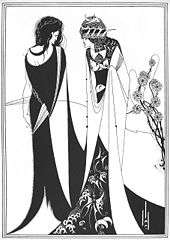
John the Baptizer and Salome
-
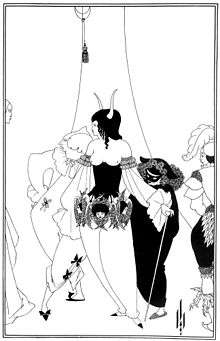
Illustration from Short stories by Edgar Allan Poe
-
.jpg)
Et in Arcadia Ego
-
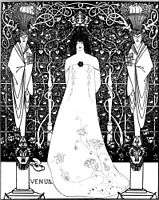
Venus between Terminal Gods
-
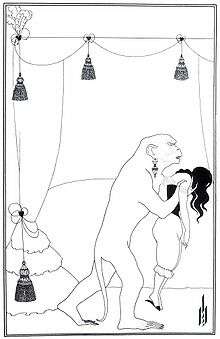
Illustration for Edgar Alan Poe's The Murders in the Rue Morgue
-

The Barge
-
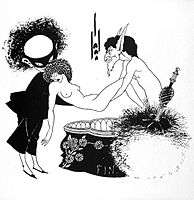
Tailpiece or Cul de Lampe, 1893
-
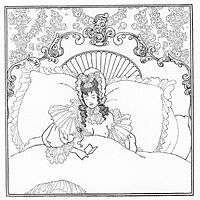
The Rape of the Lock by Alexander Pope
-

Cover of One Thousand and One Nights
-
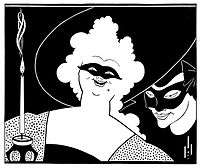
Masquerade
-

The driving of Cupid from the garden - preparatory drawing for the cover design of 'The Savoy', no.3
See also
Bibliography
- Beardsley, Aubrey, Simon Wilson, and Linda Gertner Zatlin. 1998. Aubrey Beardsley: a centenary tribute. Tokyo: Art Life Ltd. OCLC 42742305
References
- ↑ "England, Births and Christenings, 1538-1975," index, FamilySearch, accessed 4 April 2012), Aubrey Vincent Beardsley (1872).
- ↑ Sturgis, p. 8
- ↑ Sturgis, p. 10
- ↑ Sturgis, p. 3
- 1 2
 One or more of the preceding sentences incorporates text from a publication now in the public domain: Chisholm, Hugh, ed. (1911). "Beardsley, Aubrey Vincent". Encyclopædia Britannica. 3 (11th ed.). Cambridge University Press. pp. 577–578.
One or more of the preceding sentences incorporates text from a publication now in the public domain: Chisholm, Hugh, ed. (1911). "Beardsley, Aubrey Vincent". Encyclopædia Britannica. 3 (11th ed.). Cambridge University Press. pp. 577–578. - ↑ Armstrong 1901.
- 1 2 Souter, Nick; Souter, Tessa (2012). The Illustration Handbook: A Guide to the World's Greatest Illustrators. Oceana. p. 41. ISBN 978-1-84573-473-2.
- 1 2 Harris, Bruce S., ed. (1967). The Collected Drawings of Aubrey Beardsley. Crown Publishers, Inc.
- ↑ "The Life of Aubrey Beardsley" (PDF). Victorian Web. Retrieved May 8, 2012.
- ↑ Symons, Aurthus (1967). The Collected Drawings of Aubery Beardsley. New York: Crescent Books Inc. pp. v.
- ↑ Kingston, Angela. Oscar Wilde as a Character in Victorian Fiction. Palgrave Macmillan, 2007. ISBN 9780230600232
- ↑ "Beardsley and the art of decadence by Matthew Sturgis", Reviewed by Richard Edmonds in The Birmingham Post (England), Date: March 21, 1998. at thefreelibrary.com, retrieved 5 Apr 2012.
- ↑ Latham, David, ed. (2003). Haunted texts: studies in Pre-Raphaelitism in honour of William E. Fredeman. University of Toronto Press. p. 194. ISBN 978-0-8020-3662-9.
- ↑ Sturgis, Matthew (1998). Aubrey Beardsley: a biography. Harper Collins. ISBN 0-00-255789-4.
- ↑ "Aubrey Beardsley". Find A Grave. Retrieved 2013-11-08.
- ↑ Gilbert, John Selwyn, Aubrey
Sources
 Armstrong, Walter (1901). "Beardsley, Aubrey Vincent". In Sidney Lee. Dictionary of National Biography, 1901 supplement. London: Smith, Elder & Co.
Armstrong, Walter (1901). "Beardsley, Aubrey Vincent". In Sidney Lee. Dictionary of National Biography, 1901 supplement. London: Smith, Elder & Co. - Beardsley, Aubrey, Simon Wilson, and Linda Gertner Zatlin. 1998. Aubrey Beardsley: a centenary tribute. Tokyo: Art Life Ltd. OCLC 42742305
- Beerbohm, Max. 1928. 'Aubrey Beardsley' in A Variety of Things. New York, Knopf.
- Benkovitz, Miriam J. 1980. Aubrey Beardsley, an Account of his Life. New York, N.Y.: Putnam. ISBN 0-399-12408-X.
- Brophy, Brigid. 1969. Black and White; a Portrait of Aubrey Beardsley. New York, N.Y.: Stein and Day.
- Calloway, Stephen. 1998. Aubrey Beardsley. New York, N.Y.: Harry N. Abrams. ISBN 0-8109-4009-4.
- Dowson, Ernest. 1897. The Pierrot of the Minute. Restored edition with Aubrey Beardsley's illustrations, CreateSpace, 2012. Bilingual illustrated edition with French translation by Philippe Baudry, CreateSpace, 2012.
- Fletcher, Ian. 1987. Aubrey Beardsley. Boston, M.A.: Twayne Publishers. ISBN 0-8057-6958-7.
- Ross, Robert 1909. Aubrey Beardsley. London: John Lane.
- Snodgrass, Chris. 1995. Aubrey Beardsley: Dandy of the Grotesque. New York, N.Y.: Oxford University Press. ISBN 0-19-509062-4.
- Symons, Arthur. 1898. Aubrey Beardsley. London: At the Sign of the Unicorn.
- Sturgis, Matthew. 1998. Aubrey Beardsley: a biography. Woodstock, N.Y.: Overlook Press. ISBN 0-87951-910-X.
- Weintraub, Stanley. 1967. Beardsley: a biography. New York, N.Y.: Braziller.
- Zatlin, Linda G. 1997. Beardsley, Japonsime, and the Perversion of the Victorian Ideal. Cambridge: Cambridge University Press. ISBN 0-521-58164-8.
- Zatlin, Linda G. 1990. Aubrey Beardsley and Victorian Sexual Politics. Oxford: Oxford University Press. ISBN 019817506X.
- Zatlin, Linda G. 2007. “Aubrey Beardsley and the Shaping of Art Nouveau.” Bound for the 1890s: Essays on Writing and Publishing in Honor of James G. Nelson. Ed. Jonathan Allison. Buckinghamshire: Rivendale Press.
- Zatlin, Linda G. “Wilde, Beardsley, and the Making of Salome.” Scholars Library, 2007; originally published in The Journal of Victorian Culture 5.2 (November 2000): 341-57.
- Zatlin, Linda G. 2006. “Aubrey Beardsley.” Encyclopedia of Europe 1789-1914. Chicago: Gale Research.
External links
- BBC Radio 4 Great Lives programme on Aubrey Beardsley - listen online: http://www.bbc.co.uk/programmes/b01pty45
| Wikimedia Commons has media related to Aubrey Beardsley. |
| Wikiquote has quotations related to: Aubrey Beardsley |
| Wikisource has original works written by or about: Aubrey Beardsley |
- Works by Aubrey Beardsley at Project Gutenberg
- Works by or about Aubrey Beardsley at Internet Archive
- Works by or about Aubrey Beardsley in libraries (WorldCat catalog)
- Aubrey Beardsley's gravesite, Menton, France (at findagrave.com)
- Works displayed at Art Renewal Center website
- Aubrey Beardsley Collection at the Harry Ransom Center at the University of Texas at Austin
- Aubrey Beardsley Letter from the Mount Holyoke College Archives and Special Collections
